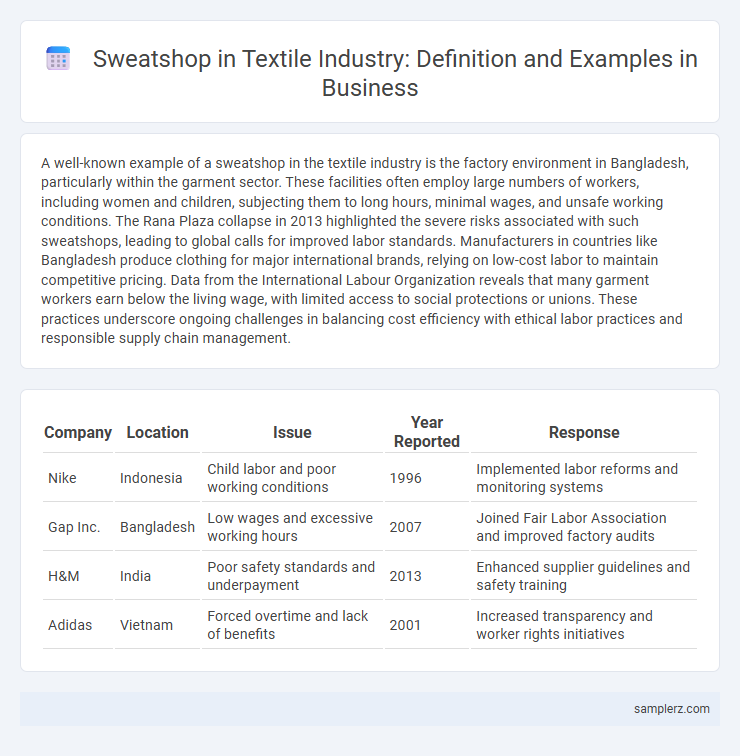A well-known example of a sweatshop in the textile industry is the factory environment in Bangladesh, particularly within the garment sector. These facilities often employ large numbers of workers, including women and children, subjecting them to long hours, minimal wages, and unsafe working conditions. The Rana Plaza collapse in 2013 highlighted the severe risks associated with such sweatshops, leading to global calls for improved labor standards. Manufacturers in countries like Bangladesh produce clothing for major international brands, relying on low-cost labor to maintain competitive pricing. Data from the International Labour Organization reveals that many garment workers earn below the living wage, with limited access to social protections or unions. These practices underscore ongoing challenges in balancing cost efficiency with ethical labor practices and responsible supply chain management.
Table of Comparison
| Company | Location | Issue | Year Reported | Response |
|---|---|---|---|---|
| Nike | Indonesia | Child labor and poor working conditions | 1996 | Implemented labor reforms and monitoring systems |
| Gap Inc. | Bangladesh | Low wages and excessive working hours | 2007 | Joined Fair Labor Association and improved factory audits |
| H&M | India | Poor safety standards and underpayment | 2013 | Enhanced supplier guidelines and safety training |
| Adidas | Vietnam | Forced overtime and lack of benefits | 2001 | Increased transparency and worker rights initiatives |
Defining Sweatshops in the Textile Industry
Sweatshops in the textile industry are characterized by poor working conditions, including low wages, excessive working hours, and unsafe environments. These factories often exploit vulnerable laborers, primarily in developing countries, to produce garments for global brands at minimal costs. The defining features include lack of labor rights enforcement, child labor, and inadequate health and safety measures.
Historical Overview of Textile Sweatshops
Textile sweatshops emerged prominently during the Industrial Revolution in the 19th century, driven by the rapid expansion of the garment industry and demand for low-cost clothing. Factories in cities like Manchester, England, and Lowell, Massachusetts, exploited laborers, including women and children, working long hours under hazardous conditions for minimal wages. This historical exploitation laid the foundation for modern sweatshop issues, highlighting the urgent need for labor reforms and ethical manufacturing practices in the global textile sector.
Notorious Global Sweatshop Cases
The Rana Plaza collapse in Bangladesh in 2013 stands as one of the most notorious global sweatshop cases, where over 1,100 garment workers died due to unsafe working conditions in textile factories supplying major brands. Another infamous example is the use of forced labor in Xinjiang, China, where reports expose the exploitation of Uyghur minorities in cotton production for international apparel companies. These cases highlight critical issues of labor rights violations, poor safety standards, and systemic corporate negligence in the global textile industry.
The Rana Plaza Disaster: A Textile Tragedy
The Rana Plaza disaster in 2013 exposed the dire consequences of sweatshop labor in the textile industry, where over 1,100 garment workers died due to a building collapse in Bangladesh. This tragedy highlighted the dangerous working conditions and exploitation common in textile sweatshops, emphasizing the urgent need for corporate accountability and improved labor standards. It remains a critical example of the human cost behind fast fashion and global supply chains.
Southeast Asia’s Textile Sweatshop Hotspots
Southeast Asia's textile sweatshop hotspots include countries such as Bangladesh, Vietnam, and Cambodia, where garment workers often endure long hours, low wages, and unsafe working conditions. Factories in cities like Dhaka, Ho Chi Minh City, and Phnom Penh have become infamous for exploitative labor practices contributing to the global fast fashion supply chain. Industry watchdog reports highlight that these regions remain critical nodes in textile production while grappling with persistent human rights violations.
Labor Exploitation in Fast Fashion Factories
Fast fashion factories often rely on sweatshop conditions where labor exploitation is rampant, exemplified by excessively long work hours, meager wages, and unsafe environments. Brands such as those producing cheap, rapid-turnover clothing frequently source from countries with minimal labor protections, exacerbating worker vulnerability. This exploitation fuels profits while perpetuating poverty and poor living standards among factory workers globally.
Child Labor in Textile Production Chains
Child labor remains rampant in textile production chains, particularly in countries like India, Bangladesh, and Pakistan, where children work under hazardous conditions for minimal wages. These sweatshops exploit minors to meet fast fashion demands, often violating international labor standards and contributing to ongoing cycles of poverty. Efforts to eradicate child labor in the textile industry focus on improving supply chain transparency and enforcing stricter regulations in manufacturing hubs.
Health and Safety Violations in Textile Sweatshops
Textile sweatshops often exhibit severe health and safety violations, including inadequate ventilation and exposure to hazardous chemicals that increase the risk of respiratory diseases among workers. Overcrowded workspaces frequently lack proper emergency exits and fire safety measures, resulting in life-threatening conditions during accidents. Reports from factories in countries like Bangladesh and Cambodia highlight persistent neglect of protective equipment and insufficient sanitation facilities, contributing to widespread occupational injuries and illnesses.
Corporate Responses to Sweatshop Allegations
Global apparel brands like Nike and H&M have faced widespread criticism over sweatshop conditions in textile factories across countries such as Bangladesh and Vietnam. In response, these corporations have implemented rigorous auditing systems, supplier codes of conduct, and collaborated with organizations like the Fair Labor Association to improve labor standards. Enhanced transparency measures and investment in worker training programs demonstrate ongoing commitments to ethical manufacturing practices.
Initiatives and Solutions for Ethical Textile Sourcing
Brands like Patagonia and Everlane have introduced transparent supply chains and fair labor certifications to combat sweatshop conditions in textile production. Collaborative initiatives such as the Fair Labor Association and the Better Work program engage factories to improve workers' rights and safety standards. Investment in sustainable materials and local sourcing further supports ethical practices by reducing dependency on exploitative labor environments.

example of sweatshop in textile Infographic
 samplerz.com
samplerz.com